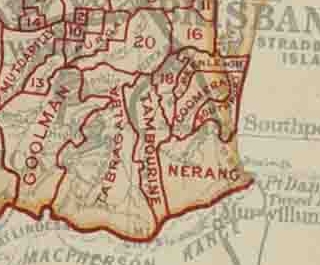1847 to 1968


Following the war, in 1947 a large amount of the now Yarrabilba estate was purchased by James Fairlie Brett. Born in 1884 in Maryborough, Queensland, Brett had significant interests in sawmills throughout South East Queensland, commencing with the manufacture of plywood in 1933 and later establishing in 1942 a business in New Guinea. As a towering industry leader, his business interests also came to include wool, gold, oil and cement. When he died in 1966, his estate was estimated to be valued at $1,578 at the time. The degree of timbergetting undertaken by Bretts at Yarrabilba is unknown, but presumed to be quite considerable with extensive logging of whatever native timbers were available at the time.
By the end of 1948, the proposed amalgamation of the Tamborine, Waterford and Beaudesert Shires were being fought by local residents. A postal poll held in November 1948 showed overwhelming opposition to the amalgamation but in spite of the residents’ feelings, the new Shire was formed. The very last recorded Minutes of the Tamborine Shire Council are dated 27 May 1949. The early representatives of our local government were responsible the setting of standards for the ideals of integrity and service, evident from their dedication and enthusiasm as they travelled long distances on horseback to attend meetings lasting a few hours and all for no renumeration or tangible reward.
From the 1950s the amount of land clearance significantly increased as a number of dairy farms in the region were subdivided into residential blocks. The cream carrying service from the mountain was soon to be discontinued, leading many of the local farmers turning to avocados and fruit. Many changes to both the landscape and industry continued with the closure of the railway in 1955.
In 1965, Paul Plunkett of Tamborine sold most of the land north of Plunkett Road to the Hancock family. Members of the Plunkett family still own and work the land from Plunkett Road south to the Albert River.
The Hancock’s business had previously been established by Josias Henry Hancock senior at South Brisbane in 1898. Josias Henry Junior, known as Harry, joined the family business as soon as he left school, and soon became the chairman of the board. The company by then was known as Hancock and Gore. His business interests were similar to that of James Brett. Hancocks also established a plywood mill in 1930-31 and became one of Australia’s largest plywood producers. He also had interests in New Guinea but was betrayed by a confidence trickster in 1944 and his firm suffered the indignity of a Royal Commission. He died the following year, leaving four sons and a wife. The Hancock brothers established a nursery to raise the seedlings and began planting Pinus Elliotti (Slash Pine) in 1966 to initially cover 16 hectares, 93 hectares in 1967, and 139 hectares the following year of 1968 – and so began the start of the ‘Pine Forest’ in Yarrabilba..
